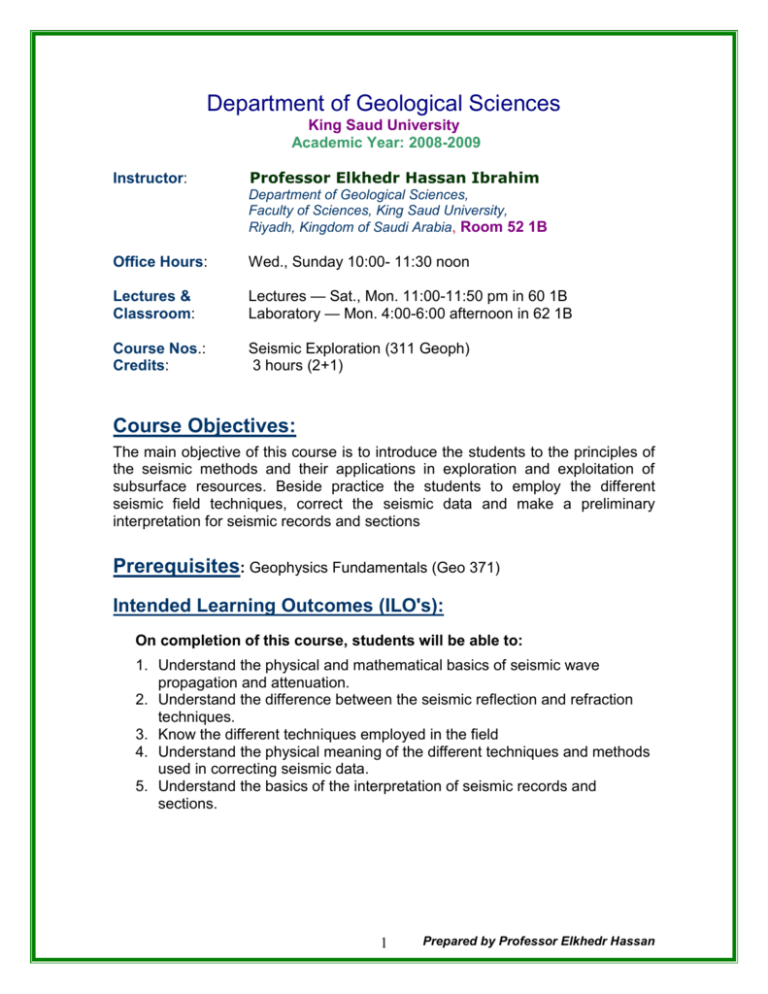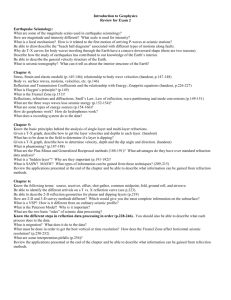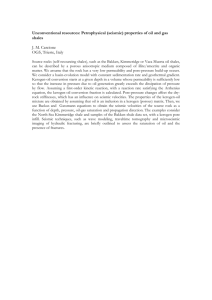Subsurface Geophysical Surveying in Archaeology
advertisement

Department of Geological Sciences King Saud University Academic Year: 2008-2009 Instructor: Professor Elkhedr Hassan Ibrahim Department of Geological Sciences, Faculty of Sciences, King Saud University, Riyadh, Kingdom of Saudi Arabia, Room 52 1B Office Hours: Wed., Sunday 10:00- 11:30 noon Lectures & Classroom: Lectures — Sat., Mon. 11:00-11:50 pm in 60 1B Laboratory — Mon. 4:00-6:00 afternoon in 62 1B Course Nos.: Credits: Seismic Exploration (311 Geoph) 3 hours (2+1) Course Objectives: The main objective of this course is to introduce the students to the principles of the seismic methods and their applications in exploration and exploitation of subsurface resources. Beside practice the students to employ the different seismic field techniques, correct the seismic data and make a preliminary interpretation for seismic records and sections Prerequisites: Geophysics Fundamentals (Geo 371) Intended Learning Outcomes (ILO's): On completion of this course, students will be able to: 1. Understand the physical and mathematical basics of seismic wave propagation and attenuation. 2. Understand the difference between the seismic reflection and refraction techniques. 3. Know the different techniques employed in the field 4. Understand the physical meaning of the different techniques and methods used in correcting seismic data. 5. Understand the basics of the interpretation of seismic records and sections. 1 Prepared by Professor Elkhedr Hassan Covered Lecture Topics 1. Physical properties of rocks, body waves, concepts of seismic velocities, Huygens principles, Snell’s law, wave propagation velocities in rocks 2. Introduction to seismic prospecting-I (methods - reflection versus refraction) 3. Seismic data collection: seismic energy sources, receivers, recorders, operations in marine and land environment 4. Seismic refraction method-I (horizontally layered models) 5. Seismic refraction method-II (dipping interface and fault problem) 6. Seismic reflection method: basic principles: geometry of reflection, reflection 7. Basic seismic data processing. 8. Common-Depth-Point (CDP) technique, Normal-Move-Out (NMO) correction, velocity analysis, and seismic velocities. 9. Stacking and stacked seismic sections, Seismic migration and migrated seismic sections 10. Introduction to interpretation Textbooks 1. Dobrin, B. M. Introduction to geophysical prospecting 2. Telford, W. M., Geldart, L. P., and Sheriff, R. E. (1990). Applied Geophysics. Cambridge University Press. 770 pages Grading Grades will be determined through the following evaluations: In class short quizzes and mid-term Exam Attendance, class participation Major and final Exam Lab. Exercises, class participation and homework assignments 15% 5% 50% 30% Important Note: If you miss a quiz (or in-class activity), you will not be able to make it up because your regular attendance is expected. 2 Prepared by Professor Elkhedr Hassan






